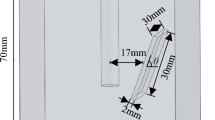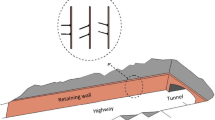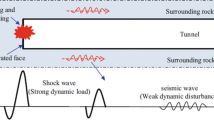Conclusions
-
1.
The use of collapse blasting for constructing rock dams substantially increases the technical and economic indices of the blasting technology of constructing earth dams.
-
2.
The selection of the technology of constructing blast-filled dams is determined mainly by the engineering-geological conditions at the construction site. At present it cannot be confirmed whether the use of loosening blasting promotes an increase of the geological properties of soils forming the body of blast-filled dams.
-
3.
Further investigations of the process of movement of blasted rock down a mountain slope with determination of the volume of moving rock, time, andvelocity (acceleration) for a known degree of slope roughness are required for a more complete comparison of the effectiveness of the two existing technologies of constructing dams by directional blasting. Such investigations also enable determining the possibility of using the Amontons-Coulomb law of friction for describing the movement of large earth masses.
Similar content being viewed by others
Literature cited
V. F. Korchevskii and M. Kh. Muratova, “Construction of dams by caving,” Gidrotekh. Stroit., No. 3 (1991).
A. E. Azarkovich and G. I. Pokrovskii, “Prediction of the particle-size distribution in blast-filled dams,” Gidrotekh. Stroit., No. 3 (1991).
N. P. Lushnov, “Modeling certain residual deformations of dam slopes made of coarse-fragmental materials with reference to calculation of their seismic stability,” in: Transactions of the Laboratory of Hydraulic Structures [in Russian], Gosstroiizdat, No. 5 (1969).
S. S. Grigoryan, “New law of friction and mechanism of large-scale rock falls and slides,” Dokl. Akad. Nauk SSSR,244, No. 4 (1979).
G. K. Klein, Structural Mechanics of Granular Bodies [in Russian], Stroiizdat, Moscow (1956).
A. V. Ostroumov, “Mechanism of friction of collapse flows,” in: Problems of Soil Thermodynamics [in Russian], Moscow State Univ. (1986).
B. V. Deryagin, What Is Friction? [in Russian], Akad. Nauk SSSR, Moscow (1963).
G. I. Pokrovskii and N. P. Lushnov, “Abrasion of rock during dam construction by loosening blasting,” Énerg. Stroit., No. 7 (1991).
Yougji Huo, “Several problems of dam construction by directional blasting,” Proc. Int. Symp. Intense Dyn. Load and Eff., June 3–7, Beijing (1986).
G. R. Adhikari and R. N. Gupta, “Some aspects of cast blasting techniques for dam construction,” Int. J. Mining Geological Eng., No. 7 (1989).
Additional information
Translated from Gidrotekhnicheskoe Stroitel'stvo, No. 7, pp. 5–8, July, 1992.
Rights and permissions
About this article
Cite this article
Pokrovskii, G.I., Lushnov, N.P. Technology of constructing blast-filled dams and geotechnical properties of soils of such structures. Hydrotechnical Construction 26, 395–400 (1992). https://doi.org/10.1007/BF01545013
Issue Date:
DOI: https://doi.org/10.1007/BF01545013




